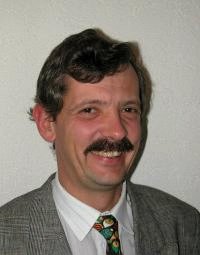Group IV Alloys: A Versatile Platform for Electronic-Photonic Integrated Circuitry (EPIC)

Speaker: Dr. Detlev Grützmacher
Affiliation: Institute for Semiconductor Nanoelectronics (PGI-9)
Abstract: Recently it has been shown that alloying Ge with Sn enables the fabrication of fundamental direct bandgap group IV semiconductors as well as optically pumped GeSn lasers grown on Si(001)[1]. This achievement might pave the route towards efficient and monolithically integrated group IV light emitters, i.e. lasers, for electronic-photonic integrated circuits (EPICs) that could solve the emerging power consumption crisis in CMOS technology by enabling optical on-chip and chip-to-chip data transfer. Changing from electrons to photons for the data transfer would lead to a tremendous reduction in energy consumption of ICs[2]. GeSn being a direct bandgap semiconductor with a small gap (~0.5 eV) might be attractive for low power electronic devices, such as T-FET´s as well. In particular, due to the small effective electron masses and having a predicted electron mobility and injection velocity exceeding that of InAs. In conclusion, GeSn may offer an attractive platform for the monolithic integration of optical and ultra-low power electrical devices.
1) S. Wirths, R. Geiger et. al., Lasing in direct-bandgap GeSn alloy grown on Si, Nature Photonics, DOI: 10.1038, (2015).
2) D. A. B. Miller, Optics for low-energy communications inside digital processors: quantum detectors, sources, and modulators as efficient impedance converters, Optics Letters, Vol. 14, No. 2, 146-148 (1989).
Biography: Detlev Grützmacher studied Physics at the Georgia Augusta University of Göttingen and the Rheinisch Westfälische Technische Hochschule in Aachen (Germany). He stayed in the group of Prof. P. Balk at the Institute of Semiconductor Electronics in Aachen for his diploma and PHD thesis from 1987 to 1991, investigating the deposition of Ga-In-As-P compounds by MOCVD for semiconductor lasers. In 1991, he received his Ph.D. degree with special honours, awarded with the Borchers Medal of the University of Aachen. From 1991-1993, he stayed for a postdoctoral position at the IBM Thomas Watson Research Centre in Yorktown Heights, New York. During this time, his research was focussed on the epitaxial growth of Si/SiGe hetero- and quantum well structures by atmospheric pressure CVD. High speed hetero-bipolar transistors as well as resonant tunnelling devices were main tasks of this research approach. This work was honoured with an IBM research division award in 1992 and a patent invention award in 1993. In spring 1993, he joined the Laboratory of Micro- and Nanotechnology at the Paul-Scherrer-Institute in Switzerland, heading the Si nanosystems activity focussing on Si-Ge anostructures for optoelectronic and electronic applications. In May 2001, he defended his habilitation at the University of Konstanz (Germany). Since October 2006, he is director of the Institute for Semiconductor Nanoelectronics (PGI-9) at the Forschungszentrum Jülich. The research spans from fundamental science in topological insulators, transport phenomena in nanowires and phase change materials to device oriented investigations based on CMOS technology. He is author and co-author of more than 350 scientific papers.
For more information, contact Prof. Subramanian Iyer (s.s.iyer@ucla.edu)
Date/Time:
Date(s) - Apr 11, 2016
3:00 pm - 4:00 pm
Location:
E-IV Tesla Room #53-125
420 Westwood Plaza - 5th Flr., Los Angeles CA 90095
